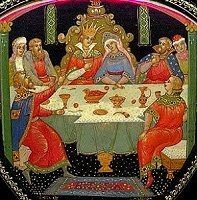A Cursory Overview of the Middle Ages I

Here's a very brief and shallow overview of the history of the Midddle Ages in Europe. The period termed the Middle Ages is between the fall of the Roman Empire in 400 AD and the beginning of the Renaissance in 1500 AD. This large era is further divided into three parts: the Early Middle Ages (400–1000ish), the High Middle Ages (1000–1300), and the Late Middle Ages (1300–1450ish). In Britain, the High Middle Ages started with the Norman Invasion in 1066.
With the fall of Rome, Germanic people invaded the former Roman Empire: the Visigoths settled in Spain; the Vandals in North Africa (retaken a 100 years later by the Byzantines); the Ostrogoths in Italy; and the Suevi and Burgundians, and Franks in France; the Huns formed a European empire; and the Angles and Saxons invaded England. The Vikings took over northern France and parts of the Mediterranean region, the Lombards replaced the Ostrogoths in Italy, and the Slavs invaded Eastern Europe. The Romans continued to dominate the small eastern Mediterranean region.
In the 600s AD, the Byzantines crushed Persia, which was subsequently taken over by Muslims. The Muslims also took over Carthage, while the Slav occupation of the Balkans began. The Slav-Persian joint raid of Constantinople was foiled, but the Arabic conquest succeeded.
 By 700 AD, the Islamic empire took over Spain and North Africa. In France and Germany, Charlemagne built the Holy Roman Empire. In Russia, the Vikings and Slavs built a kingdom together in a rare moment of collaboration in history. The Viking attacks on Britain began.
By 700 AD, the Islamic empire took over Spain and North Africa. In France and Germany, Charlemagne built the Holy Roman Empire. In Russia, the Vikings and Slavs built a kingdom together in a rare moment of collaboration in history. The Viking attacks on Britain began.
Around 1000 AD , the beginning of modern England, France, and Germany can be seen. The Spanish Reconquest began Europe's fight against Islamic rulers. The Crusades took the fight into Jerusalem. Italy was still struggling between the unification under the Holy Roman Empire and its individual kingdoms. Poland and Russia continued to be fractured into kingdoms. The Roman Empire now known as the Byzantine Empire was losing ground to the Seljuks.
In the Late Middle Ages, Poland, Russia, and Italy profited from the Mongol Empire's Silk Road trade. By the early 1300s, however, Europe suffered from both war and disease, like the bubonic plague, which killed millions of people and led to the collapse of the Mongol Empire. England and France began to fight the Hundred Years' War, while Germany and Italy fought a long series of wars as well. The last of the Crusades ended in failure. Scotland is now de jure independent.
The end of the Silk Road trade in the 1400s forced traders to look for other ways to get things from China and India. Explorers began to try to find a way to sail from Europe around Africa to China. In 1453, the Ottomans conquered the last traces of the Roman Empire in Constantinople. In 1492, Spain forced the last Muslim rulers out of Granada and the Spanish found a sea route to the new world, thereby establishing trade routes independent of the Mongol and the Arabic ones.

0 comments:
Post a Comment